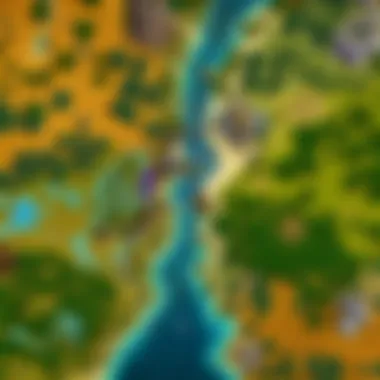Exploring Realm Population Dynamics in WoW: TBC


Intro
The realm population in World of Warcraft: The Burning Crusade (TBC) is a topic that holds importance for players seeking an optimal gameplay experience. Understanding how realm dynamics function can influence everything from character selection to community interaction. Players often choose realms based on population size and activity level, which can directly affect their in-game experiences. In this analysis, we will uncover the layers of factors shaping these dynamics, explore historical and contemporary trends, and offer strategies for effectively navigating the diverse gaming environment.
Game Updates and Patch Notes
Overview
World of Warcraft constantly evolves through updates and patches. These changes can significantly impact realm populations and player experiences. In The Burning Crusade, several updates aimed at balancing gameplay, enhancing user experience, and addressing community feedback. Staying updated with these changes is crucial for players aiming to optimize their strategies.
Patch Highlights
Key updates in TBC often include:
- New classes and races: The introduction of Draenei and Blood Elves expanded player options.
- Raid adjustments: Changes in raid mechanics shifted player focus and required teams to adapt.
- PvP modifications: Alterations to battlegrounds and arenas impacted player-versus-player strategies.
These highlights represent just a fraction of how updates can shape gameplay. A thorough understanding of each patch allows players to grasp how these updates influence realm populations.
Impacts
The ramifications of updates are far-reaching. For example, changes to class strengths can lead to population shifts in specific realms. When a class becomes favored due to a patch, more players migrate to realms that support that class, potentially impacting server stress and gameplay quality. Other than that, meta shifts necessitate that players regularly reassess their realm choice and play strategies.
Player Distribution and Activity Levels
Overview
Realm distribution is a key aspect of TBC. Players often choose realms based not only on personal preference but also on their anticipated gameplay experience. Popular realms have active communities, enhancing the multiplayer experience, while low-population realms may lead to challenges in finding groups or participating in large-scale events.
Factors Influencing Distribution
Several factors play a role in how players distribute across realms:
- Time zone: Players tend to align with others in similar time zones for scheduling convenience.
- Gameplay style: Different realms cater to various modes of play, such as PvE or PvP.
- Community reputation: Some realms develop reputations based on their community culture, which can attract or repel players.
Understanding these factors can help players strategically choose their preferred realm. A well-aligned choice can significantly enhance the overall experience in WoW TBC.
Navigating Realm Choices
Practical Strategies
Choosing the right realm is essential, but it can also be complicated. Here are some strategies players can employ:
- Research realm populations: Websites and databases often track population sizes and activities, helping players select vibrant realms.
- Engage with community forums: Utilizing platforms such as reddit.com can provide insight into player experiences on various realms.
- Join Discord servers: Many realms have Discord communities where players can interact and receive real-time information about activities.
Finale
Gaining a thorough understanding of realm population dynamics in World of Warcraft: TBC can shape how players approach their gaming experience. By analyzing updates, player distribution, and effective navigation strategies, one can create a holistic and rewarding experience. This knowledge empowers players to make informed decisions and ultimately enhances the satisfaction derived from the gameplay.
Prelims to WoW: TBC
Understanding World of Warcraft, particularly the Burning Crusade expansion, is crucial for players who want to navigate its complexities effectively. This section serves as a doorway into the broader dynamics of realm populations, which will be discussed thoroughly in the following segments.
Players must grasp both the game's foundation and the specific features introduced with TBC. This knowledge is essential not only for gameplay enhancement but also for making informed decisions about realm selection. Realms have distinct populations, and these influence experiences significantly. By understanding how realms function and the impact of TBC, players can optimize their gaming experience.
Overview of World of Warcraft
World of Warcraft, also known as WoW, is a massively multiplayer online role-playing game (MMORPG). It was released in 2004 by Blizzard Entertainment. WoW invites players to explore a vast world filled with lore, quests, and engaging gameplay mechanics. Players create their avatars, known as characters, and delve into the rich narratives provided by both the original game and its various expansions.
WoW combines exploration, combat, and teamwork. The game encourages players to interact with others, forming communities, clans, and friendships throughout their journeys. Realm selection plays a role here, as different realms offer diverse experiences. Some may have a larger player base, while others cater to niche communities, affecting social interaction.
The Burning Crusade Expansion


The Burning Crusade, released in 2007, is the first expansion of WoW. It expanded the game world, adding new continents and a wealth of new content. Players can now venture to Outland, engage with new factions, and battle formidable foes. This expansion also introduced two playable races: the Blood Elves and the Draenei, each altering the dynamics of race selection among players.
In addition to new content, TBC brought forth significant gameplay changes, impacting the gaming landscape. Higher level caps, new dungeons, and more challenging raids fueled player growth and exploration. Understanding these features is essential for any player wanting to grasp the realm population dynamics that will be covered in later sections.
The Burning Crusade marked a turning point in WoW's history when it vastly expanded the game’s lore and gameplay options.
Overall, acknowledging the context of WoW and TBC is vital for appreciating the realm population dynamics that shape player experiences.
Realm Population: An Essential Concept
Realm population is a crucial aspect of World of Warcraft: The Burning Crusade, impacting gameplay and community dynamics. It involves the number of players on a specific realm and influences various factors such as resource availability, competition for quests, and social interactions. Understanding realm population helps players choose where to create their characters, which can significantly affect their gaming experience.
Moreover, knowing the dynamics of realm population allows players to adapt their strategies for leveling up and engaging in player versus environment or player versus player activities. Selecting a realm with a vibrant community or low population can shape not just how players interact but also their overall enjoyment and efficiency in the game.
Defining Realm Population
Realm population refers to the number of players actively participating on a particular server in WoW. This concept is essential because it illustrates the level of activity within the game environment. A realm with a high population often has more events, players to interact with, and available resources, leading to a more vibrant and active gaming experience. Conversely, lower population realms may lead to fewer opportunities for interaction and a less crowded gameplay experience.
Types of Realms in WoW
World of Warcraft offers several realm types designed to accommodate different play styles and preferences. Each type has its own characteristics and attracts different player demographics.
Normal
Normal realms are the default choice for players seeking a balanced gameplay experience. They allow players to engage in combat, quests, and other activities without the constant threat of being attacked by other players. This type is a good option for those who prefer a more relaxed approach to the game. Players can enjoy PvE content, leveling, and socializing without the stress of frequent PvP encounters. However, the downside may be that players miss the adrenaline rush found in more aggressive environments.
PvP
Player versus Player realms provide a competitive atmosphere that can be exhilarating for many players. These realms allow for open-world combat between players at any time. The key characteristic of PvP realms is the opportunity for constant engagement with other competitors, which can lead to thrilling encounters and challenges. PvP realms can be attractive for those seeking intense, dynamic gameplay. However, new players may find this environment challenging as they learn the game mechanics.
RP
Role-playing realms cater specifically to players looking to immerse themselves in the lore and narrative of WoW. Participants create characters with backstories and often engage in character-driven gameplay. This type of realm encourages creativity and community building among players. The unique feature of RP realms is the focus on storytelling and character development, making it ideal for players who enjoy this aspect of gaming. However, those who prefer to focus solely on gameplay may find the emphasis on role-playing less appealing.
RP-PvP
RP-PvP realms blend the elements of role-playing with player versus player combat. It allows players to engage in both character-driven narratives and competitive battles against others. This realm type appeals to a niche audience that enjoys elements of both styles. The dual nature provides both storytelling opportunities and the thrill of PvP combat. However, balancing both interests can be difficult, as not every player may find both aspects enjoyable.
Factors Influencing Realm Population
Understanding the factors influencing realm population within World of Warcraft: The Burning Crusade is crucial for any player. These elements shape the overall dynamics of gameplay, community interaction, and the overall environment in which players exist. Players who grasp these factors can make informed decisions that enhance their gaming experience. Various components work together to shape population density, including historical development, gameplay mechanics, player interactions, and geographical distribution.
Historical Context
The historical context of WoW realms cannot be ignored. When The Burning Crusade was released in 2007, it had a profound impact on player distribution. Many players flocked to new or existing realms that offered opportunities to experience the expansion's new content. Realms that had previously struggled with low populations saw a surge, while some heavily populated realms faced issues with overcrowding.
The trends observed during this time period offer valuable insights into how community behavior evolves. For new players, understanding the legacy of different realms can help identify which ones might suit their needs. For example, realms known for a strong community or rich history may attract players seeking social engagement or competition.
Gameplay Mechanics and Updates
Game mechanics and updates are pivotal in shaping realm population dynamics. Changes in gameplay balance, introduction of new systems, and seasonal events all play a part in how players choose their realms. When a new update is released, it can create waves of migration as players flock to realms that seem most promising for the new content.
The introduction of paid services, like realm transfers, has also affected population distribution. Players often seek out realms with favorable conditions such as high activity or specific community types. This service can lead to imbalances where some realms become overpopulated, while others may struggle to maintain a healthy player base.
Player Community Dynamics
The dynamics of player communities within realms greatly influence population trends. Realms often form distinct communities based on shared interests, play styles, or goals. A competitive PvP realm might attract a different player base compared to a role-playing realm, creating unique environments. The health and activity level of these communities matter immensely; active guilds, events, and social interactions can draw in new players and retain existing ones.
Communities that are welcoming and engaging often thrive. Vibrant social interactions lead to greater visibility of the realm, making it more appealing to potential new members. Conversely, realms with toxic environments may see population declines as players leave for more congenial spaces.
Geographical Distribution of Players


Geographical distribution of players also impacts realm population. Players may prefer realms based on latency, time zones, and language. Realms that cater to specific geographical locations tend to have a more stable population because players know they will have optimal connectivity and community interaction.
In addition, cultural attributes often emerge on realms, with groups forming around languages or regions. This makes it simpler for players to communicate and engage without significant barriers. Over time, this geographical aspect has led some realms to develop reputations as the best options for particular player demographics.
The Role of Realms in Player Experience
The realm a player chooses in World of Warcraft: The Burning Crusade significantly shapes the overall experience. Realms serve as the digital homes where players explore, engage, and interact with others. The type of realm can affect everything from gameplay opportunities to social interactions. Understanding this can help players make informed decisions that enhance their gaming journey.
Impact on Gameplay
Gameplay in WoW is heavily influenced by the realm type. Different realms offer unique settings, affecting the goals and strategies players pursue. A PvP realm, for instance, emphasizes competitive play and constant conflict, as players can attack each other at any time. This creates a tense environment that appeals to those seeking adrenaline and competition.
In contrast, a Normal realm offers a more casual experience, allowing players to focus on quests and leveling up without the threat of random attacks. This realm type is often preferred by players who enjoy exploring lore, completing quests, or engaging in cooperative play without the pressure of being ambushed by enemies.
The selection of realm can also impact access to certain content. On some realms, there might be an influx of players participating in large events such as raids or battlegrounds. This can directly affect the availability and ease of forming groups for challenging in-game activities. Hence, gameplay dynamics shift significantly depending on realm selection.
Community Interaction
Community is at the heart of many multiplayer experiences, and realms play a critical role in shaping these communities. On heavily populated realms, players may find vibrant communities with numerous guilds, events, and social activities. This leads to a rich tapestry of interactions that can enhance personal connections and collaborative gameplay.
Conversely, on less populated realms, player interaction may feel limited. Players might struggle to find active guilds or even friends to tackle challenges with. Smaller communities can feel more intimate but might lack the same opportunities for large-scale collaboration or events. The balance between engagement and the sense of community can vary widely across different realms.
Ultimately, the realm chosen dictates not only the gameplay experience but also the type of social interactions a player can expect. A well-considered choice can significantly elevate the enjoyment of the game.
"The choice of realm can dramatically influence a player's engagement level and interaction with the broader WoW community."
In summary, realms in WoW: TBC are not merely technical limitations but rather foundational elements that shape the player experience. Understanding their impact is crucial for optimizing both gameplay and community engagement.
Analyzing Realm Populations in TBC
Understanding realm populations in World of Warcraft: The Burning Crusade is vital for players looking to optimize their gaming experience. This section delves into both current trends and historical changes, revealing the nuances of player distribution and how it affects gameplay.
Players must grasp how many people inhabit their chosen realm. This knowledge plays an important role in shaping their game. A vibrant, populated realm can offer more opportunities for community involvement, collaboration in raids, and access to a bustling market. Conversely, a low-population realm may lead to isolation and less engagement with allies.
Further, analyzing realm populations equips players with the insights needed to make informed choices. Those who are new can select realms that promise active communities, while veterans can learn to adapt strategies based on realm trends.
Current Trends and Data
The landscape of realm populations in WoW: TBC is constantly evolving. Recent data indicates shifts in player preferences and migration patterns across realms. Many players are drawn to realms with high activity levels, leading to a noticeable uptick in population metrics.
Reports from gaming forums and databases provide valuable insights. For instance, forums on Reddit often discuss which realms are thriving, highlighting how realms such as Faerlina and Whitemane have become hotspots for active players. This data serves as a practical guide for new players seeking an engaging environment.
Some characteristics of these trends include:
- Increased faction balance: Players are evenly distributed between Alliance and Horde on many realms, fostering competitive play.
- Player clusters: Certain realms attract specific demographics, with groups forming around similar playstyles or regional proximities.
- Event participation: Realms with organized events, such as raid nights or tournaments, tend to experience population spikes.
"Understanding the current state of realm populations is essential to enhance one's gaming experience in WoW: TBC."
Changes Over Time
The dynamics of realm populations have transformed significantly since the launch of The Burning Crusade. Historical data reveals a correlation between game updates and shifts in player distributions.
For example, when patches introduce new content or features, there is often a redistribution of players seeking to explore fresh experiences. Conversely, a lack of updates can lead to stagnation.
Analyzing the timeline of player migrations often aligns with key moments, such as the announcement of new expansions or significant changes in gameplay mechanics.
Key changes include:
- Expansion releases: New expansions typically draw players to specific realms.
- Promotional events: Special promotions can lead to sudden increases in population on certain servers.
- Transfers and merges: Changes in realm structure, like server merges, have reshaped communities, blending distinct player groups.
Over time, these movements reflect broader trends within the gaming community. Understanding these shifts allows players to anticipate potential changes in their favor or against their interests.


Choosing the Right Realm
Choosing the right realm in World of Warcraft: The Burning Crusade is a pivotal decision for players, influencing not just gameplay but overall gaming experience. The realm you select dictates factors such as player interaction, access to specific community events, and even your gaming style. Whether you are a new adventurer or a seasoned veteran, understanding the different realms can significantly affect your immersion and satisfaction in the game.
Players should weigh options based on several considerations. These include the realm type, current population trends, and the specific gameplay mechanics that each realm offers. Selecting a realm that aligns with one's preferences helps to foster a more enjoyable environment. In WoW, realms are categorized into distinct types—Normal, PvP, RP, and RP-PvP—each serving unique demographics and gameplay styles.
Considerations for New Players
For newcomers, making the right realm choice can be daunting. Prioritizing ease of gameplay and community interaction is often essential. Here are some vital considerations for new players:
- Realm Type: Familiarize yourself with the type of realm. A Normal realm provides a focused PvE (Player vs. Environment) experience while PvP realms engage players in hostile encounters.
- Population Density: Check the current population of the realm. A low-population realm may provide a quieter experience but limited player opportunities. In contrast, a highly populated realm could lead to crowded areas but more community activities.
- Community Dynamics: Observe community culture in forums or social media platforms like Reddit or Facebook. Engaging with the community before diving in can offer insights into realm attitudes and social environments.
Strategies for Experienced Players
Experienced players, while better equipped to navigate realm selections, also need to consider strategic factors when choosing a realm:
- Competitive Edge: Evaluate your goals. If aiming to complete high-level raids or ranked battlegrounds, select a realm known for its competitive community. Being in a realm with skilled players enhances personal growth and team success.
- Friends and Guilds: Connectivity remains crucial. Joining a realm where friends or guilds are established can improve your gaming experience significantly. Social bonds often lead to better group dynamics in gameplay.
- Role Playing Considerations: For those seeking immersive experiences on RP realms, consider the lore and role-playing opportunities available. Engaging within a contextually rich environment can deepen investment in your character and narrative.
By applying these considerations and strategies, players at all levels can make informed decisions regarding pairing with a suitable realm.
"The right realm doesn't just shape your character's journey; it enhances every aspect of your World of Warcraft experience."
As the game continues to evolve and the community alters, remaining adaptable becomes necessary. The selected realm will serve as the foundation for adventures ahead.
Future Outlook for Realm Populations
Examining the future of realm populations in World of Warcraft: The Burning Crusade is vital for understanding how player dynamics may evolve. With each expansion and patch, Blizzard Entertainment influences realm activity. Players must consider how potential updates might affect their gaming environments. These changes will shape not only player distribution but also the community experience itself.
As players grow increasingly aware of the importance of realm choice, they must analyze possible future developments and trends. Keeping abreast of these elements can grant them competitive advantage, influence gameplay, and facilitate better community interaction.
Potential Developments
Potential developments in realm populations can stem from several sources. They include:
- Game Updates: New patches and expansions commonly introduce changes in gameplay that can attract or deter players.
- Server Merges: Blizzard may merge realms to enhance player activity. This decision can dramatically shift population figures in affected servers.
- Player Preferences: Emerging gaming trends influence players' choices. For instance, if a new playstyle gains popularity, it may lead to increased population in specific types of realms.
These developments shift the landscape of realm populations. Paying attention to announcements from Blizzard can help guide decision-making for players.
Long-Term Trends to Watch
Several long-term trends will likely shape realm populations, warranting careful observation. Key elements to consider include:
- Community Growth: The introduction of more players or returning veterans can increase activity, leading to a vibrant community.
- Transmogrification and Cosmetics: As more players seek unique aesthetics, role-playing realms may gain traction, affecting population distribution.
- Remote Play Trends: Changes in lifestyle, such as more players gaming from home due to various factors, can spread populations across realms differently than in the past.
"Understanding these emerging trends can help players make informed decisions about realm selection and community involvement."
Overall, recognizing these dynamics will be essential for anyone interested in navigating the complexities of realm populations in World of Warcraft: The Burning Crusade. Keeping informed through resources such as Wikipedia, Britannica, Reddit, and Facebook can provide crucial insights into these developments.
Epilogue
The conclusion serves as a crucial element in synthesizing the various insights gleaned throughout the exploration of realm populations in World of Warcraft: The Burning Crusade. It highlights the importance of understanding how realm dynamics affect player experiences, providing a consolidated view of the key findings discussed in the article. Additionally, this section emphasizes the implications for players, urging them to consider the long-term ramifications of their realm choices on gameplay and community interaction.
Summary of Key Findings
In summarizing key findings, it becomes clear that realm population is influenced by multiple factors, including historical events, gameplay mechanics, and player community dynamics. Factors such as server type can dictate player behavior and interaction. For instance, PvP realms often attract competitive players seeking challenging encounters, while RP realms cater to those desiring immersive storytelling experiences.
Moreover, the geographical distribution of players plays a significant role in realm population trends. High player density can enhance interaction, but it can also lead to overcrowding and resource competition, impacting gameplay quality. Ultimately, the data collected reveals a complex interplay of influences shaping realm populations.
Implications for Players
Understanding these dynamics can significantly impact player choices in WoW. New players should carefully consider their realm selection to ensure a fulfilling experience. Picking a less populated realm could mean quieter gameplay, but it may also limit community interaction and opportunities for engaging in group content.
For seasoned players, the knowledge of realm dynamics aids in strategizing for optimal gameplay experiences. Migrating to a more populated realm might enhance access to resources and group content, but it could also come with the challenges of increased competition and social dynamics.
"Realm population is more than just a number; it dictates the very fabric of community and gameplay experience in WoW."
Thus, as players navigate the vast world of WoW: TBC, they must keep these implications in mind, cultivating an awareness of how their choices can enhance or hinder their overall gaming experience.







